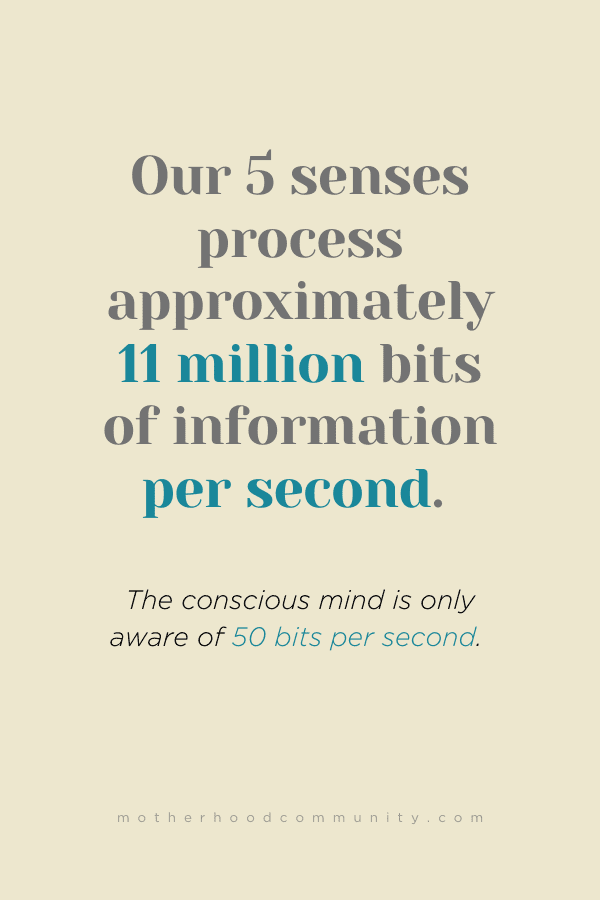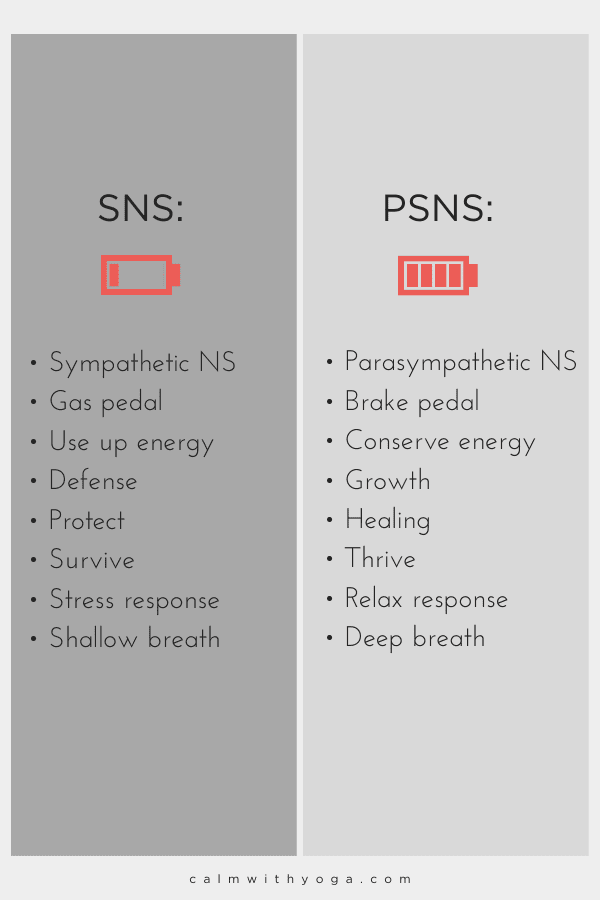To be calm is the highest achievement of the self.
– Unknown
Stress is unavoidable and can, under the right conditions, even be beneficial.
We can’t escape stress, but we can befriend it.
We can learn to control ourstress responseand channel that energy in constructive and creative ways.
If you’re experiencing chronic stress or feeling constantly on edge chances are you’ve got an overactive sympathetic nervous system.
This is the branch of your nervous system that dictates the fight or flight response.
It can take a few tweaks and some new habits but with consistency and willingness, you can transform chronic stress and use it to your advantage.
This means more well-being, mental health, physical resilience, inner calm, insight, creativity, and healing.
It also means being able to connect with your kids and partner more mindfully and not being as reactive or irritable at home.
Keep reading to find out how to calm your nervous system down so you can face the challenges, uncertainty, and demands before you with more poise, inner knowing, and awareness…
Your Body Is Intelligent & Wise – The Signs of An Overactive Nervous System
Your nervous system, in fact, is a circulating nervous system.
It thinks.
It’s conscious.
– Deepak Chopra, doctor & author
Your body is wise and intelligent.
The crowning achievement of the intelligence of thehuman bodyis the nervous system.
Everything you perceive through your senses – everything you can see, hear, taste, smell, intuit, and touch is processed through the nervous system.
Like a good gatekeeper, it helps you maneuver through life by keeping track of every single little sensory detail of your experience so you don’t consciously have to.
Your nervous system is constantly sifting through astounding amounts of data while it scans your environment and processes your surroundings.
It matches incoming sensory information with previously recorded data in order to match relevant patterns:
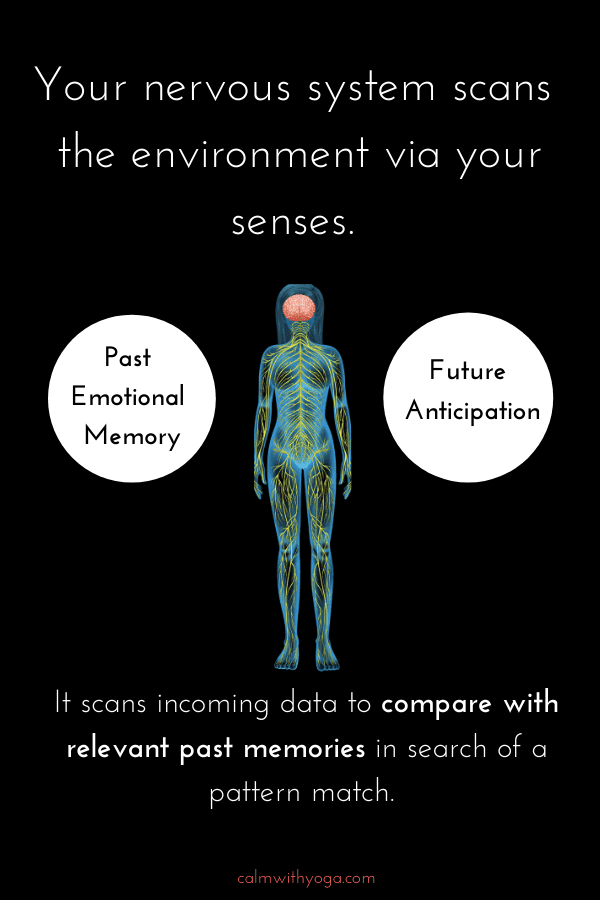
When you’re chronically stressed or overwhelmed you tend to keep reacting in the same emotional way over and over.
This conditions your nervous system to potentially (mis)read your environment based on past experiences, and the associations and perceptions you’ve formed around those experiences.
It also trains your mind to automatically think more negative thoughts and have more pessimistic expectations.
That can often translate to being more short-fused with your children or partner, or even making incorrect assumptions about them based on your past.
Your nervous system, being the intelligent processor and gatekeeper, diligently keeps seeking and running those old-patterned programs and subconscious emotional memories over and over recreating the same or similar experiences, and reactions in an attempt to match the old pattern.
This creates a vicious cycle that can leave you feeling exhausted, drained, or overly emotional.
Most of this happens underneath your conscious and voluntary level of awareness.
The speed at which your nervous system processes all of this environmental information is lightning quick.
This is why you so often feel like your mental and emotional state is out of your control.
This is what leads to anoveractive sympatheticnervous system.
Understanding Your Own Nervous System & How It Functions
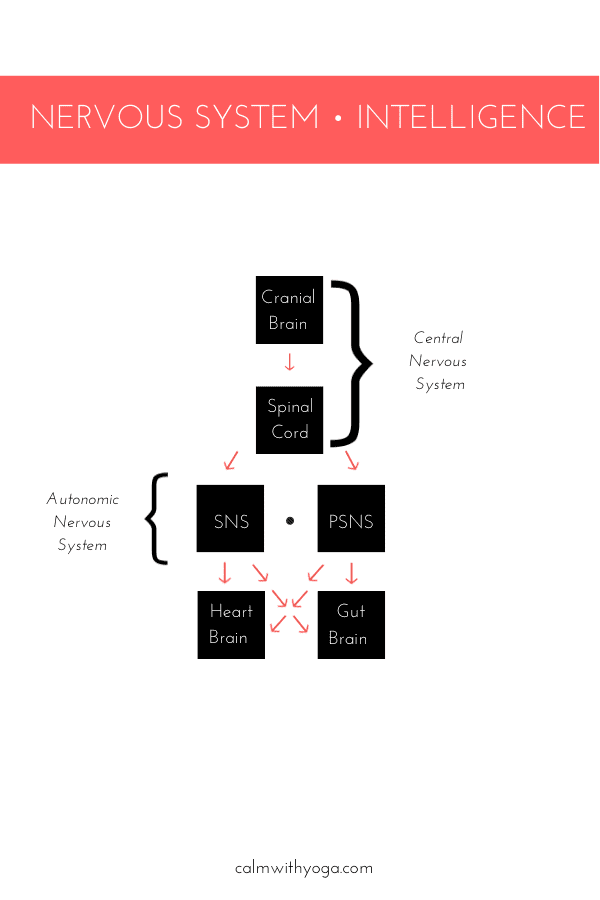
Yourstress responseis linked to yourautonomic nervous system (ANS), which is a part of yourperipheral nervous system(PNS).
Your ANS oversees vital and basic body functions such as blood sugar, breathing, heart rate, and blood pressure/blood flow.
It communicates with yourcentral nervous system(CNS) which is comprised of your brain andspinal cordand also interacts with yourimmune system.
The ANS is divided into two branches.
This is how the two systems work:
1 – The Sympathetic Nervous System (SNS)
Think ofSNSactivityas the gas pedal – the moresympathetic activitythe more you are mobilizing and using up vital energy.
The SNS oversees the stress response and so, is activated when you perceive something as potentially painful, dangerous, or life-threatening.

Back in the caveman days, theSNSis what kept us alive – if we saw a tiger and had to literally run for our lives theSNSis what gave us that jolt of energy to fight or flee.
TheSNSactivates youradrenal glandsto producestress hormoneslike norepinephrine (noradrenaline) that signal your body to get onhigh alert.
Withincreasedheart rateyou’re now ready for intensephysical activity(fight or flee).

We may not be encountering real-life tigers today, but we do experience a wide range of situations that feel painful, dangerous, or life-threatening.
Especially right now.
Whether they’re real (actually life-threatening) or perceived your body and nervous system process them all in the same way – by activating your SNS.
If we don’t learn to self-soothe, recalibrate, and self-regulate, we’ll soon experience physical imbalance which can lead to other issues such as highblood pressure,heart diseaseorheart failure, autoimmune issues,blood sugar issues, and evenmental healthissues.
2 – TheParasympathetic Nervous System(PSNS)
If theSNSis the gas pedal that accelerates energy in your body then the PSNS is the brake pedal that slows it all down and balances it all out.

Yourparasympathetic systemsoversee therelaxation response- which is also known as the calming response or the regenerative response.
All healing takes place in this restorative system.
Blood pressure drops, heart rate goes down, blood sugar regulates, heart ratevariability(HRV) goes up, and immune function strengthens.
That’s why it’s extremely important to create habits in daily life that activate this branch while creating a more calm sympathetic nervous system.
How To Calm The Sympathetic Nervous System In 3 Steps
The main idea to remember here is that you lower SNS activity (stress) by activating PSNS activity.
This helps you take your foot off the gas pedal and leave it on the brake pedal long enough to create some real healing and wholeness.
Here are 3 proven ways to activate your parasympathetic (relaxation) response:
1 – Breathing Exercises
Deep intentional belly breathing with your lower abdomen is one of the fastest and easiest ways to awaken yourparasympathetic nervous system.
This is because of thevagus nerve, a major parasympathetic nerve that runs from the base of your head down your ear and throat and down to your abdominal and digestive organs.
Every time you breathe with your belly you activate your diaphragm and yourvagus nervewhich acts as an automatic chill pill.
Try this breathing meditation to help get you started.
2 – Gratitude Practice
It turns out that a regular gratitude practice is powerful medicine and can even help to re-wire an anxious brain for the better.
Maybe that’s why the yogic practice of contentment (Santosha) is one of the key practices on the true yogic path.
The Institute of Heartmath has spent the last 20-something years researching how certain emotional states impact your overall heart intelligence andwell-being.
According to their research positive emotions and positive feelings such as gratitude, appreciation, contentment, and inspiration activate heart coherence and PSNS activity.
By the same token, negative emotions create a state of incoherence and activateSNSactivity.
Heartmath measuredheart ratevariabilitywhile experiencing different emotional states and found that:
“Distinct heart rhythm patterns characterize different emotional states…
Sustained emotions such as appreciation, care, compassion, and love generate a smooth, sine-wave-like pattern in the heart’s rhythms.
This reflects increased order in higher-level control systems in the brain, increased synchronization between the two branches of the ANS, and a general shift in autonomic balance towards an increased parasympathetic activity.” (5)
The graphs below are illustrations of HMI HRV readings.
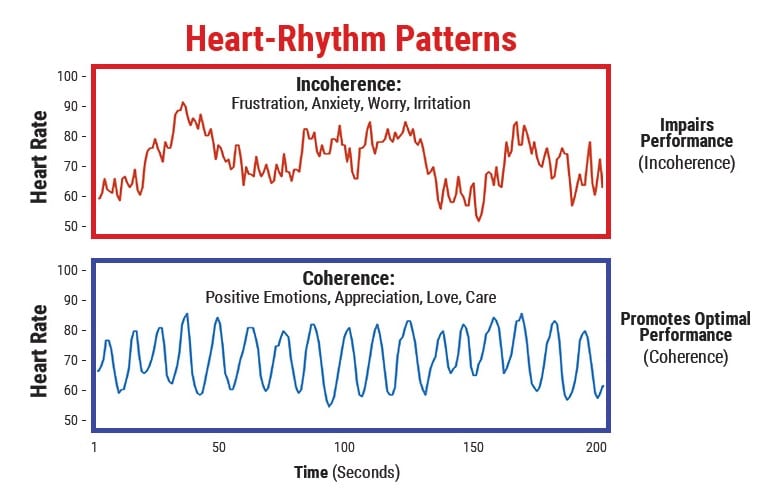
The top red is during a moment of frustration.
Notice the erratic, jagged pattern.
The bottom blue was recorded during a moment of appreciation.
Notice the more harmonious, sine-wave like pattern.
3 – Chanting
Believe it or not, chanting and humming are a proven way to stimulate yourvagus nerveand increase vagal tone.
This means that it can help you increase inner calm by activating your parasympathetic response.
Yourvagus nerveruns from the base of your head down your ear and throat, down to your heart, and your digestive andinternalorgans.
According to Dr. Stephen Porges and his Polyvagal Theory, the vibrations from the vocalizations of chanting out loud or humming actually “wake up” yourvagus nerveso it comes online.
If you’re new to chanting or want some further guidance here’s a quick mantra meditation session.
If you commit to doing any of these three things on a regular basis you will train your body to enter the ‘calm space’ that inevitably increases health andwell-being.
The more you do this the more your total power increases – mental power, emotional power, physical power, and even creative power.
Just remember that controlling your breath, gratitude journaling, and chanting/humming can be soothing and help each successive heartbeat slow down and create more space.
By calming down the stress response and learning how to self-soothe and self-regulate we become better versions of ourselves.
This means that we can also model to our kids how they can self-soothe and self-regulate.
You got this, mama.
REFERENCES
:
(1)https://www.heartmath.org/resources/downloads/science-of-the-heart/



